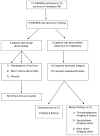Whole-body magnetic resonance imaging (WB-MRI) as surveillance for subsequent malignancies in survivors of hereditary retinoblastoma: a pilot study
- PMID: 24402721
- PMCID: PMC4007376
- DOI: 10.1002/pbc.24835
Whole-body magnetic resonance imaging (WB-MRI) as surveillance for subsequent malignancies in survivors of hereditary retinoblastoma: a pilot study
Abstract
Background: Individuals with hereditary retinoblastoma (RB) are at very high risk of developing subsequent malignant neoplasms (SMNs) of which osteosarcoma (OS) is one of the most common. We hypothesized that annual surveillance using whole-body magnetic resonance imaging (WB-MRI) in asymptomatic survivors of hereditary RB would detect SMN of the bone and soft tissues at an early stage.
Procedure: Retrospective review of the results of a WB-MRI screening program in hereditary RB survivors from February 2008 to August 2012. The primary outcome was to determine the sensitivity and specificity of WB-MRI in detecting SMNs.
Results: Twenty-five patients had at least one WB-MRI performed (range: 1-5). First WB-MRI was performed at a median age of 16 years (range: 8-25 years). WB-MRI detected new osseous abnormalities suspicious for malignancy in five patients: two were diagnosed with localized high-grade OS of the extremity and three were found to have benign osseous abnormalities after dedicated imaging (n = 5/5) and/or biopsy (n = 3/5). One patient was diagnosed with secondary OS 3 months after a normal screening WB-MRI exam. Among a total of 41 WB-MRI screening tests performed in survivors of hereditary RB, the sensitivity of detecting SMN was 66.7% and the specificity was 92.1%.
Conclusions: Preliminary results suggest that annual WB-MRI surveillance detects SMN in survivors of hereditary RB, but with modest sensitivity. Further study is needed to assess the performance of annual surveillance WB-MRIs and whether this modality decreases SMN-related mortality in RB survivors.
Keywords: pediatric oncology; retinoblastoma; screening; survivors; whole-body MRI.
© 2013 Wiley Periodicals, Inc.
Figures



References
-
- Broaddus E, Topham A, Singh AD. Survival with retinoblastoma in the USA: 1975–2004. The British journal of ophthalmology. 2009;93(1):24–27. - PubMed
-
- Kleinerman RA, Tucker MA, Abramson DH, et al. Risk of soft tissue sarcomas by individual subtype in survivors of hereditary retinoblastoma. Journal of the National Cancer Institute. 2007;99(1):24–31. - PubMed
-
- MacCarthy A, Bayne AM, Draper GJ, et al. Non-ocular tumours following retinoblastoma in Great Britain 1951 to 2004. The British journal of ophthalmology. 2009;93(9):1159–1162. - PubMed
-
- Marees T, Moll AC, Imhof SM, et al. Risk of second malignancies in survivors of retinoblastoma: more than 40 years of follow-up. Journal of the National Cancer Institute. 2008;100(24):1771–1779. - PubMed
-
- Moll AC, Imhof SM, Bouter LM, et al. Second primary tumors in patients with retinoblastoma. A review of the literature Ophthalmic genetics. 1997;18(1):27–34. - PubMed
Publication types
MeSH terms
Grants and funding
LinkOut - more resources
Full Text Sources
Other Literature Sources
Medical

